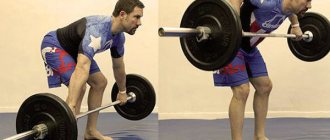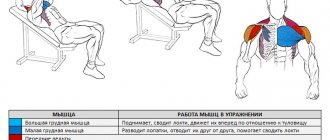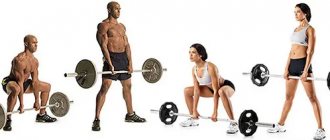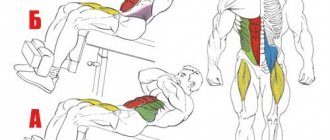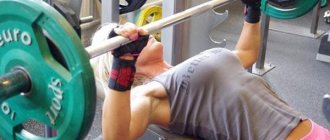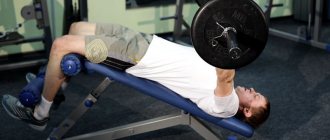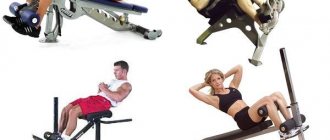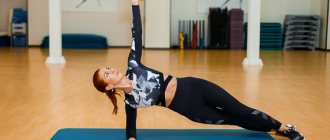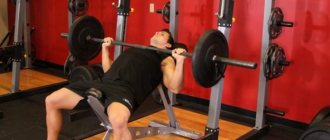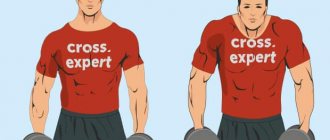Dumbbell rows lying on a bench are an exercise for the latissimus dorsi muscles. It takes the pressure off your legs and helps isolate your back muscles. The movement is intended for those who find it difficult to bend over due to overloaded hamstrings, quadriceps and buttocks. These people have a tendency to push the weight with their legs and not fully engage their lats. Therefore, the variation with a bench is ideal for them. This version of the exercise also takes some of the load off the spine.
Pros and cons of deadlifts with emphasis on the bench
Pros:
- The great advantage of this basic exercise is that the athlete’s spine and body position are securely fixed.
- The athlete can also perform the movement with different grips and adjust the inclination when performing the exercise. Tilt allows you to change the emphasis from one part of the back to another.
- The exercise effectively affects the back muscles.
- Relevant for both men and women.
- It can be performed by early-age athletes, since when performing the lying row there is no axial (any) load on the spine.
- This exercise allows you to work with heavy weights.
- Excellent for those athletes who have problems with the lumbar spine.
Minuses:
- The exercise is inferior in comfort and convenience to such specially created structures for working the back muscles, such as a lever bar or a T-bar. In fact, after introducing the bench row into the training process, the athlete quickly gets used to it.
- Also, when the back of the bench is positioned horizontally, the range of motion is short.
Errors during the exercise
- Twisting the body.
- Lowering the head.
- Rounding the back. Use an incline bench if you have trouble keeping your back straight.
- Craving to the chest, not to the stomach; jerks, decrease in amplitude during the approach. These errors are less dangerous than those listed earlier, but they render the exercise useless. Reduce the burden. If you are doing the exercise while standing, try bending deeper.
- An attempt to move the hands away from the body.
- Biceps tension. Concentrate on your back muscles, change your movements so that you feel them working.
- Trembling supporting hand. Change its position, if it does not help, do the exercise with both hands at the same time.
Wide grip barbell row
This exercise is performed on a horizontal bench or in an inclined position with emphasis on the bench.
What muscles work
- The emphasis of the load falls on the latissimus dorsi muscles.
- When performing a bending exercise, the emphasis shifts to the upper back, namely the round muscles and even the posterior deltoid muscles.
Execution technique
- Before performing the exercise, you need to place the barbell under the bench at the level of the pectoral muscles.
- The athlete should take a face-down position, gripping the bar wider than shoulder-width apart.
- Traction, upward movement, is carried out due to the work of the back muscles. The arm muscles should not be involved in the work. The weight rises as you exhale.
- At the top point of the amplitude it is necessary to make a short delay.
- In this exercise, it is better to use a curved bar, as it will give you a greater range of motion.
- As you exhale, you need to slowly lower the bar.
Execution technique
Initial position
- Set the backrest of the incline bench so that the angle of inclination varies from 30 to 45 degrees;
- Raise the seat to a comfortable height for support;
- Take the dumbbells in your hands, removing them from the floor by extending the knee and hip joints;
- Take the starting position, pressing your stomach and chest to the surface of the bench;
- Tighten your stomach, stabilize your shoulder blades so that your back muscles are slightly engaged;
- Place your feet on the floor;
- Relax your neck, move your shoulders away from your ears.
Movement
- Begin to bring your shoulder blades toward your spine;
- Then, as it were, pull both halves of the back towards the spinal column;
- Arms bend at the elbows when tension is felt in the back;
- The dumbbells are brought to the middle of the waist, and the peak contraction is held for several seconds;
- Then the reverse movement is performed, but slowly;
- First, the back muscles relax, then the athlete lowers the dumbbells, straightening his arms;
- The movement continues until the back feels stretched;
- All repetitions planned by the plan are carried out.
Lying dumbbell row: technique and nuances
Attention
- This is an isolation movement, not a strength movement. Dumbbells that are too heavy can only interfere with proper activation of the muscles. Work with moderate weights so as not to feel overloaded;
- Do not lift the dumbbells with jerks, try not to fidget on the bench;
- The chin should not touch the bench;
- You should not bend in the lower back and thereby throw the dumbbells.
Barbell row with a narrow grip to the waist while lying on a bench
Rows with this grip can be performed on a bench installed at an incline or horizontally.
What muscles work
This version of the exercise is aimed at training the latissimus and central back muscles. These are the rhomboid muscles and the trapezius muscle. The teres major muscles are also involved in the work.
Execution technique
There is no difference in performing rows with a narrow and wide grip on a bench. The only thing worth mentioning is the grip. Hands on the bar should be placed at shoulder level, and should be pulled towards the waist.
Common Mistakes
Inaccuracies in technique lead to a decrease in the effectiveness of training. In addition, some inconsistencies during execution are dangerous for the joints or spine. It is necessary to reduce the weight of the dumbbells and change the modification of the exercise if the following signs are noted when performing deadlifts:
- there is not enough strength for a full lift, the hand with the projectile moves only half the amplitude;
- the beginning of the pull is performed with a jerk, the biceps muscles working at the moment of start indicate a shift of the load from the desired muscle zones;
- “round”, the back is hunched, which means there is not enough stretching - it is worth considering the option of an incline bench;
- the head is tilted forward, which violates the anatomical position of the spine and creates a risk of pinching;
- The dumbbells are pulled to the chest, not to the stomach.
If the technique is followed, then after training the athlete feels fatigue in the muscles between and under the shoulder blades. During training, the athlete concentrates on the correct distribution of muscle work; the biceps and arm flexors should be minimally loaded. Only in this way will dumbbell rows give the desired result and become a key exercise for strengthening the back.
Beginners and experienced athletes regularly perform bent-over dumbbell rows. The classic base is modified for different levels of training, performed with small and large weights. This is a great way to get a balanced, developed back, work the latissimus muscles and improve your posture.
Parallel grip dumbbell row lying on a bench
This exercise is similar to the deadlift in a lever machine. You can also perform a similar exercise with dumbbells while standing, but rowing while lying on a bench is a safer option and allows athletes who have problems with the lumbar spine to work. Read more about dumbbell rows →
What muscles work
During rowing, the latissimus dorsi muscles work. Their work is supplemented by the teres major muscles. Also, a small part of the load falls on the posterior deltoid muscles, rhomboid muscles and trapezius muscle.
Execution technique
The principle of operation does not change in this version of traction. When pulling to the waist, the dumbbells move along the bench.
Increased efficiency
There is no need to rush to include bent-over rows in your training complex, start with high weights and a large number of approaches. At the first stage, you should try different types of exercises and choose the speed of execution. They start with light dumbbells to master the technique and feel the working muscle groups:
- At the top point, pause for 1–2 seconds and fix the position of the arm for peak muscle contraction. The elbow is not moved to the side or forward; the movement of the joint should occur close to the body, so the desired muscle group is loaded.
- If the weight of the dumbbells is heavy or a lot of repetitions are being done, use straps to attach the dumbbells to the wrist. The devices relieve excessive grip tension.
- Bent-over dumbbell rows with one hand are repeated an equal number of times for the right and left halves of the back muscles. The body is held motionless, without moving the lower back to the side. If it is not possible to maintain the starting position unchanged, then reduce the weight of the projectile.
It is important to follow the correct techniques at moments when the projectile is at the extreme points of the amplitude. The dumbbell is not thrown down, tension is maintained in the back muscles, and the elbow joint is slightly bent. The lowered hand is placed perpendicular to the floor, not pressed to the legs.
The movement of the joint should occur close to the body
Recommendations for implementation in training
- The prone row is a basic strength exercise that is best included in your workout as an additional exercise.
- The best option would be to perform the exercise after pull-ups and lat pull-downs.
- The training scheme for building muscle is simple: 3-4 sets of 8-12 repetitions.
- The exercise can be included in a superset with antagonist muscles, for example, incline dumbbell press + bench row.
- The exercise is perfect for women too. For women's training, the number of approaches will not have to be changed, but the repetitions will be 15-20.
- If the exercise is performed as part of a weight loss workout, the number of repetitions can be increased to twenty-five.
Number of approaches and weight used
To calculate the number of approaches and repetitions, as well as the weight used, you can use standard rules designed for any bodybuilding exercise. You should choose a weight that allows you to perform about 12 repetitions per set. Number of approaches – 3–5.
Since the bench row is one of the few exercises that specifically develops the rear deltoids, perform it at the beginning of your workout.
Few people come to the gym solely to pump up this part of the delta. As a rule, it is included in a regular shoulder program and placed at the end of the workout. This is not a completely correct position, since the front and central bundles receive a good load during other exercises, while the back remains idle. This can lead to disharmony in the structure of your shoulder girdle.
That is why we strongly recommend that you set aside one day, at least once every couple of weeks, for a detailed and intensive study of this delta bundle.
When and with what to do it
I included Australian pull-ups in, in fact, the formation of the future strong upper back (trapezius, lats) begins with them. For beginners, I would advise aiming for 6 sets of 12 slow full repetitions with a straight, wide grip, then moving on to regular pull-ups.
I myself use this exercise, as I said above, for pumping at the very end of back training. Since this exercise has a finishing role, all six approaches are failures, and in each approach I slightly increase the speed of the exercise.
Good luck in training, a strong body and a powerful will.
We were never able to find out why the Australian pull-ups are called that way, although we scoured half the Internet and asked all the athletes we knew (interesting!). A more familiar and understandable name is pull-ups on a low bar. The exercise is very simple and very effective. Perfect for both beginners and experienced athletes.
Experienced athletes can use more complicated variations of Australian pull-ups, which will be discussed at the end of this article.
Home workout equipment
To perform the Australian version of pull-ups, you need a horizontal bar located approximately 1.5 meters from the floor. At home, a spacer bar in the door, which can be fixed at the desired height, is ideal for this task. You can use one of the bars from the horizontal bar+bars+press complex as a crossbar.
There is another option - throw a long belt over a wall or ceiling horizontal bar, grab the ends with your hands and pull yourself up. This is not exactly the same as pulling up to the bar, but it can also be used as an option to diversify the load. This is even more difficult than pulling up to a low bar.
Execution technique
Starting position – heels on the floor, hands holding the bar, arms straight, legs straight, body also straightened, pelvis does not sag. We begin to slowly pull the body towards the bar until the top touches the chest. We don't make any sudden movements. Having reached the end, we freeze for a second and slowly lower ourselves down. As always, the downward movement lasts approximately twice as long as the upward movement.
Most beginners experience the most resistance at the end when they need to touch the bar with their chest. To do this, you need to bring your shoulder blades together. Do not make a jerk under any circumstances
to achieve the goal! It is better to do the exercise with a shorter amplitude, over time the result will come and you will be able to do everything correctly.
When performing Australian pull-ups, the body should not bend, the legs should remain straight.
. Stabilizing muscles work. Don't let yourself relax! If your preparation is not enough to perform 5-6 repetitions cleanly, you can bend your legs a little at first. You should aim to increase the number of repetitions to 10-15 in 3-4 sets (depending on your goals and other exercises in the workout).
What grip should I use for pull-ups?
Possible options are limited by your imagination. You should start with a straight middle grip, then you can switch to a reverse grip - this way the biceps and the bottom of the lats are more involved. A great option is wide-grip Australian pull-ups. It will help increase the number of pull-ups on a regular horizontal bar with a wide grip. When working with a wide grip, the pectoral muscles and latissimus muscles are activated as much as possible.
If it is very easy for you, you can raise the bar higher
.
The higher you raise the bar, the closer you get to normal pull-ups. We recommend combining Australian pull-ups on a low bar with push-ups
. Antagonist muscles work, which provides an excellent load.
What muscles work?
Australian pull-ups work all the same muscle groups as regular pull-ups. Mainly involved are the latissimus dorsi, trapezius muscles, biceps, pectoral muscles, abs, deltoids
, + a lot of other muscles of the back and arms get a load. The load is less, since part of the weight lies on the floor. There are differences in the nature of muscle work, but they are insignificant.
Varieties of Australian pull-ups for advanced
If you think this exercise is very easy for you, we recommend trying pylometric Australian pull-ups with a clap or with a change of grip
. Another complication option is to do pull-ups with one arm. And of course, no one canceled a vest with weights or a backpack with sand on your back.
When not to
Despite all the obvious benefits of this exercise, there are also contraindications:
- spinal hernia, protrusion;
- kyphosis or lordosis - increased curvature;
- fresh back injury;
- uncontrolled epilepsy, parkinsonism;
- pinched nerve endings;
- active inflammation in the spine (spondylitis);
- myelitis;
- abscesses and leaks in the spine;
- vertebral osteomyelitis;
- spinal tuberculosis;
- febrile body temperature;
- 2 months after birth;
- 4-5 months after cesarean section and any abdominal surgery;
- In the last trimester of pregnancy.
Beginning athletes are not recommended to carry heavy weights without preparation, because this can lead to injury even to a healthy back.
Care should be taken when performing after injuries during the rehabilitation period. There are limitations here: low weight, slow increase and control by the trainer. In some cases, special back bandages are used.
Contraindications to performing deadlifts
Since sport is designed to strengthen and not undermine health, take into account the few contraindications that exist for performing bent-over barbell rows:
If you have back problems
The position of the body when performing this exercise is anatomically not entirely natural for our body, since it creates a strong axial load on the lumbar spine and increases intra-abdominal pressure. For this reason, athletes with diseases of the spine or musculoskeletal system should approach performing bent-over barbell rows with special caution.
Presence of an umbilical hernia
Also, performing this type of deadlift is contraindicated for athletes with an umbilical hernia. In this case, it is better to replace this exercise with a similar one, but with less axial load. It will be a little more difficult to achieve the desired result, but you will not aggravate existing injuries and maintain athletic longevity.
What's the benefit
In addition to training the muscles and shaping the relief of the back (a beautiful triangle due to the latissimus), this exercise develops coordination well.
You need to strictly follow all stages of the pull, maintain your posture and monitor the position of your arms, legs, and head. This, in turn, develops the nervous system: after all, all this needs to be managed.
With a light weight, the exercise is useful for people during the rehabilitation period after back injuries and with neuromuscular diseases.
Strengthening the spine also occurs due to dumbbell rows.
With regular exercise, such traction can reduce scoliosis. But for such a process you need to study for at least 3-4 months. Strengthening the muscle frame also helps with other diseases: joint hypermobility, osteochondrosis, osteoarthrosis and even spondylitis, if the disease phase is inactive. The purpose of the exercise is to make your back stronger and healthier.
Next stage
Once you have picked up the dumbbells, you need to:
- clasp them with your hands so that your fingers point inward, towards the body, use an open neutral grip;
- lower your hand along the body;
- the elbow moves parallel to the lateral line of the back;
- as you exhale, lift your arm from the dumbbells to chest level;
- feel the contraction between the shoulder blades;
- move your elbow back a little, increasing the contraction;
- slowly lower down.
Don't forget about the negative phase of the exercise. After lifting, you need to lower slowly, for 3-4 seconds while inhaling. With the next exhalation, repeat the exercise.
In the case of two hands, try to bring your shoulder blades together as much as possible. It is not a mistake to bring your elbows closer together when performing a two-arm deadlift. You need to do 10-12 repetitions to maintain tone or 6-8 with heavy weight to gain body weight.
After loading, complete your sets with a back stretch. Need to:
- stand up straight;
- place your feet shoulder-width apart;
- join hands in a lock;
- bring them forward and round your back, holding for 30 seconds;
- then raise your arms up and bend;
- tilt your body with your arms to one side, then to the other;
- exhale and shake your hands.
Congratulations, your bent over row set is complete!
General information
It is one of the main exercises that helps increase the volume of the back muscles and give relief. In addition, as a result of regular and correct execution of the exercise, the athlete’s strength increases.
Performing the exercise involves several options
One of the most significant advantages of this exercise is its ease of implementation. You can train muscles in this way without complex devices and simulators. To perform the exercise, a bench and dumbbells are enough. In some variants, athletes refuse the bench.
Also, performing this exercise has a number of undeniable advantages:

